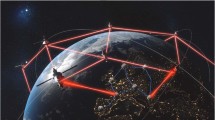Abstract
This paper focuses on the return link of a GEO satellite system that collects information from a large number of sparsely distributed IoT devices in a large geographical area. Narrow-Band (NB) IoT transmissions, with suitable Modulation and Coding Scheme (MCS), are Detected-and-Forwarded onboard the satellite, mapping each QAM symbol of the radio access link (uplink) into another PAM symbol that modulates optical feeder link’s intensity (downlink). Given the massive number of IoT devices that is expected to be served by the GEO satellite system, the feeder link (downlink) of the return channel is expected to be the bottleneck. To tackle this limitation, time-packing signaling is used in the waveform that modulates the intensity of the optical feeder link (downlink); this way, the symbol time is reduced, and the number of IoT devices that can be simultaneously served in the radio access link (uplink) can augment without increasing the signal bandwidth in the optical feeder link. The Inter-Symbol Interference (ISI) that the time-packed feeder link generates is partially mitigated in the satellite gateway, using for this purpose an adaptive linear equalizer. After optical-to-electrical conversion, the NB-IoT codewords that are received in the gateway are decoded, correcting simultaneously errors introduced in both radio access and optical feeder links. The aim of this paper is to evaluate the error correction capability that MCS of NB-IoT standard has when used to protect end-to-end the hybrid radio/optical return link that results, particularly when using large overlapping factors in the optical feeder link to increase its achievable data rate.
This work has received funding from the Spanish Ministry of Science, Innovation and Universities under project TERESA-TEC2017-90093-C3-1-R (AEI/FEDER, UE) and from the Catalan Government under grants 2017-SGR-891 and 2017-SGR-1479.
Access this chapter
Tax calculation will be finalised at checkout
Purchases are for personal use only
Similar content being viewed by others
References
3GPP: LTE; Evolved universal terrestrial radio access (E-UTRA); Multiplexing and channel coding. 3GPP tech. specification, TS 36.212, Ver. 15.9 Rel. 15 (2018)
3GPP: LTE; Evolved universal terrestrial radio access (E-UTRA); Physical channels and modulation. 3GPP tech. specification, TS 36.211, Ver. 15.2 Rel. 15 (2018)
3GPP: LTE; Evolved universal terrestrial radio access (E-UTRA); Physical layer procedures. 3GPP tech. specification, TS 36.213, Ver. 15.9 Rel. 15 (2018)
Bas, J., Dowhuszko, A.: Linear time-packing detectors for optical feeder link in high throughput satellite systems. In: Proceedings of 1st Mosharaka International Conference on Emerging Applications of Electrical Engineering, pp. 1–6, September 2020
Bas, J., Dowhuszko, A.: Time-packing as enabler of optical feeder link adaptation in high throughput satellite systems. In: Proceedings of 5G World Forum, pp. 1–7, September 2020
Bas, J., Pérez-Neira, A.: On the physical layer security of IoT devices over satellite. In: Proceedings of European Signal Processing Conference, pp. 1–5, September 2019
Dowhuszko, A., Mengali, A., Arapoglou, P., Pérez-Neira, A.: Total degradation of a DVB-S2 satellite system with analog transparent optical feeder link. In: Proceedings of IEEE Global Communications Conference, pp. 1–6, December 2019
Forney, G.: Maximum-likelihood sequence estimation of digital sequences in the presence of intersymbol interference. IEEE Trans. Inform. Theory 18(3), 363–378 (1972)
Haykin, S.: Adaptive Filter Theory: International Edition. Pearson Education Limited, London (2014)
Leibrich, J., Ali, A., Paul, H., Rosenkranz, W., Kammeyer, K.: Impact of modulator bias on the OSNR requirement of direct-detection optical OFDM. IEEE Photonics Technol. Lett. 21(15), 1033–1035 (2009)
London School of Economics: Nanosatellite telecommunications: A market study for IoT/M2M applications, August 2017
Mazo, J.: Faster-than-Nyquist signaling. Bell Syst. Tech. J. 54, 1451–1462 (1975)
Mengali, A.: Optical feeder link satellite systems. In: Link Optimization in future generation satellite systems, chap. 4, pp. 61–86. Ph.D. thesis, University of Luxembourg, October 2018
Modenini, A.: Advanced transceivers for spectrally efficient communications. Ph.D. dissertation, January 2014
Northern Sky Research: M2M and IoT via satellite 10, December 2019
Rusek, F., Anderson, J.: Constrained capacities for Faster-than-Nyquist signaling. IEEE Trans. Inform. Theory 55(2), 764–775 (2009)
Ungerboeck, G.: Adaptive maximum-likelihood receiver for carrier-modulated data-transmission systems. IEEE Trans. Commun. 22(5), 624–636 (1974)
Viterbi, A.: Error bounds for convolutional codes and an asymptotically optimum decoding algorithm. IEEE Trans. Inform. Theory 13(2), 260–269 (1967)
Author information
Authors and Affiliations
Corresponding author
Editor information
Editors and Affiliations
Rights and permissions
Copyright information
© 2021 ICST Institute for Computer Sciences, Social Informatics and Telecommunications Engineering
About this paper
Cite this paper
Bas, J., Dowhuszko, A.A. (2021). End-to-End Error Control Coding Capability of NB-IoT Transmissions in a GEO Satellite System with Time-Packed Optical Feeder Link. In: Peñalver, L., Parra, L. (eds) Industrial IoT Technologies and Applications. Industrial IoT 2020. Lecture Notes of the Institute for Computer Sciences, Social Informatics and Telecommunications Engineering, vol 365. Springer, Cham. https://doi.org/10.1007/978-3-030-71061-3_5
Download citation
DOI: https://doi.org/10.1007/978-3-030-71061-3_5
Published:
Publisher Name: Springer, Cham
Print ISBN: 978-3-030-71060-6
Online ISBN: 978-3-030-71061-3
eBook Packages: Computer ScienceComputer Science (R0)




